Health and Illness: A Sociological Perspective
VerifiedAdded on 2020/04/21
|13
|3283
|200
AI Summary
This assignment delves into the complex relationship between health, illness, and society. It explores various concepts of health and illness, analyzes social patterns influencing health disparities, and investigates the impact of factors like race and ethnicity on access to healthcare. The document draws upon diverse sources including academic journals, WHO publications, and government reports to provide a comprehensive understanding of these critical issues.
Contribute Materials
Your contribution can guide someone’s learning journey. Share your
documents today.

Running Head: Law 1
Law
Law
Secure Best Marks with AI Grader
Need help grading? Try our AI Grader for instant feedback on your assignments.
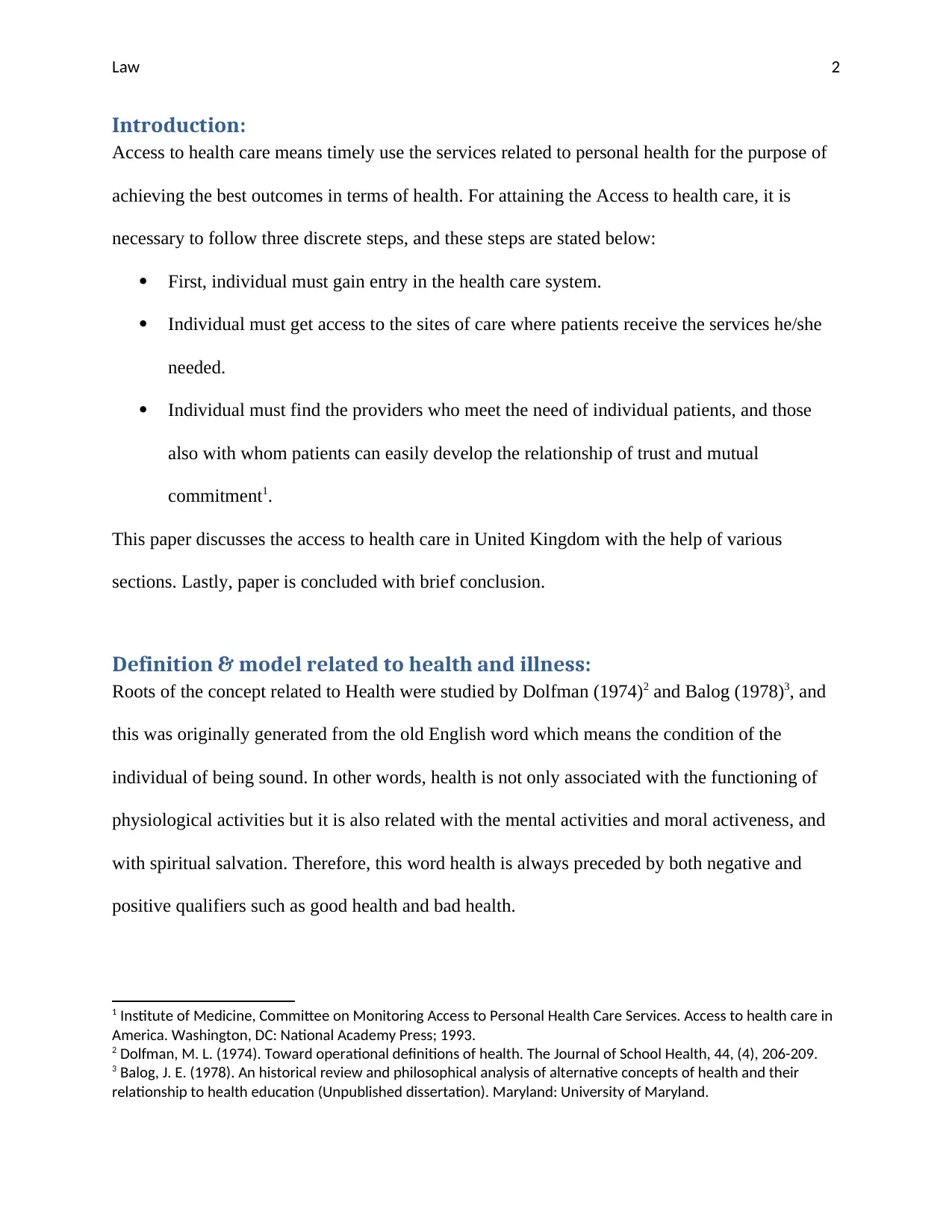
Law 2
Introduction:
Access to health care means timely use the services related to personal health for the purpose of
achieving the best outcomes in terms of health. For attaining the Access to health care, it is
necessary to follow three discrete steps, and these steps are stated below:
First, individual must gain entry in the health care system.
Individual must get access to the sites of care where patients receive the services he/she
needed.
Individual must find the providers who meet the need of individual patients, and those
also with whom patients can easily develop the relationship of trust and mutual
commitment1.
This paper discusses the access to health care in United Kingdom with the help of various
sections. Lastly, paper is concluded with brief conclusion.
Definition & model related to health and illness:
Roots of the concept related to Health were studied by Dolfman (1974)2 and Balog (1978)3, and
this was originally generated from the old English word which means the condition of the
individual of being sound. In other words, health is not only associated with the functioning of
physiological activities but it is also related with the mental activities and moral activeness, and
with spiritual salvation. Therefore, this word health is always preceded by both negative and
positive qualifiers such as good health and bad health.
1 Institute of Medicine, Committee on Monitoring Access to Personal Health Care Services. Access to health care in
America. Washington, DC: National Academy Press; 1993.
2 Dolfman, M. L. (1974). Toward operational definitions of health. The Journal of School Health, 44, (4), 206-209.
3 Balog, J. E. (1978). An historical review and philosophical analysis of alternative concepts of health and their
relationship to health education (Unpublished dissertation). Maryland: University of Maryland.
Introduction:
Access to health care means timely use the services related to personal health for the purpose of
achieving the best outcomes in terms of health. For attaining the Access to health care, it is
necessary to follow three discrete steps, and these steps are stated below:
First, individual must gain entry in the health care system.
Individual must get access to the sites of care where patients receive the services he/she
needed.
Individual must find the providers who meet the need of individual patients, and those
also with whom patients can easily develop the relationship of trust and mutual
commitment1.
This paper discusses the access to health care in United Kingdom with the help of various
sections. Lastly, paper is concluded with brief conclusion.
Definition & model related to health and illness:
Roots of the concept related to Health were studied by Dolfman (1974)2 and Balog (1978)3, and
this was originally generated from the old English word which means the condition of the
individual of being sound. In other words, health is not only associated with the functioning of
physiological activities but it is also related with the mental activities and moral activeness, and
with spiritual salvation. Therefore, this word health is always preceded by both negative and
positive qualifiers such as good health and bad health.
1 Institute of Medicine, Committee on Monitoring Access to Personal Health Care Services. Access to health care in
America. Washington, DC: National Academy Press; 1993.
2 Dolfman, M. L. (1974). Toward operational definitions of health. The Journal of School Health, 44, (4), 206-209.
3 Balog, J. E. (1978). An historical review and philosophical analysis of alternative concepts of health and their
relationship to health education (Unpublished dissertation). Maryland: University of Maryland.
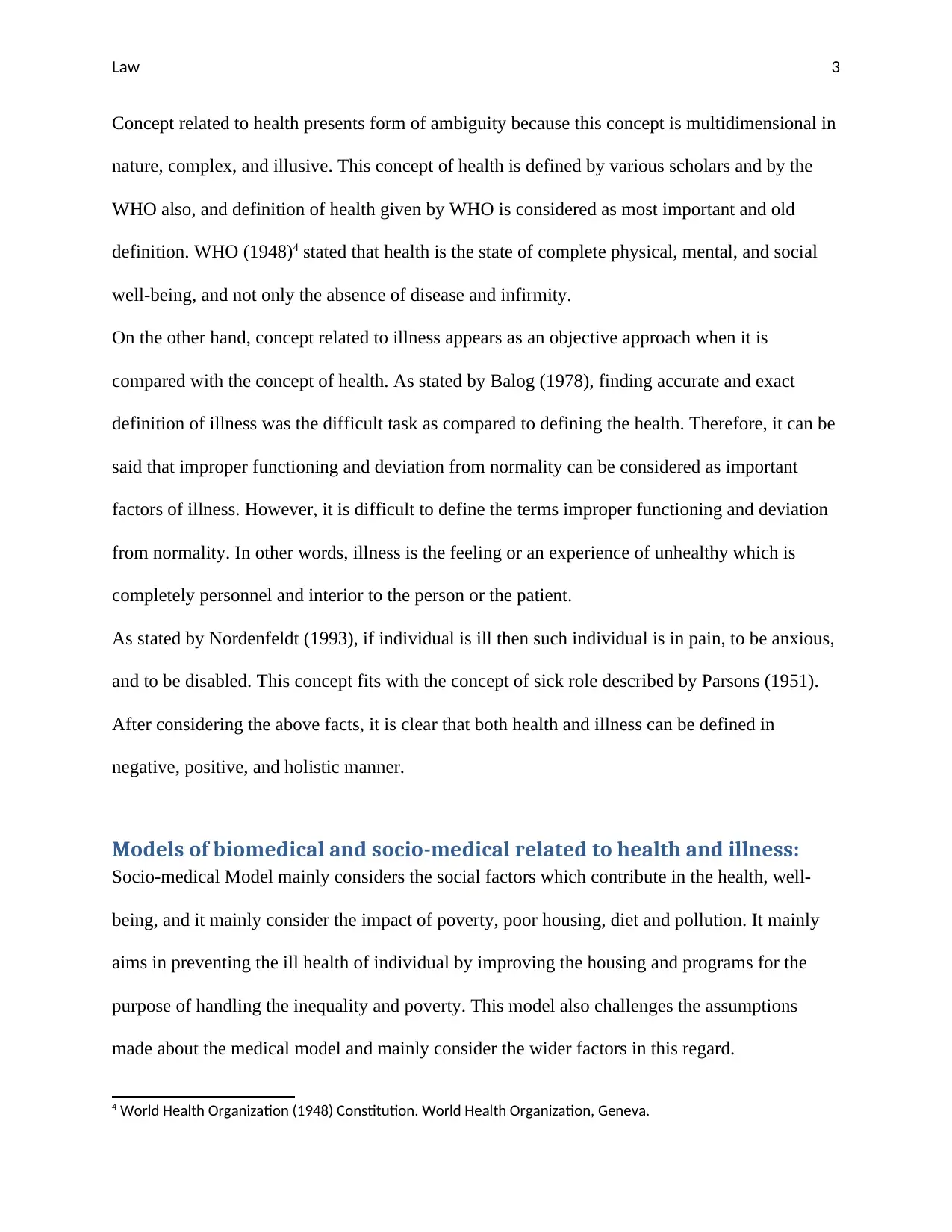
Law 3
Concept related to health presents form of ambiguity because this concept is multidimensional in
nature, complex, and illusive. This concept of health is defined by various scholars and by the
WHO also, and definition of health given by WHO is considered as most important and old
definition. WHO (1948)4 stated that health is the state of complete physical, mental, and social
well-being, and not only the absence of disease and infirmity.
On the other hand, concept related to illness appears as an objective approach when it is
compared with the concept of health. As stated by Balog (1978), finding accurate and exact
definition of illness was the difficult task as compared to defining the health. Therefore, it can be
said that improper functioning and deviation from normality can be considered as important
factors of illness. However, it is difficult to define the terms improper functioning and deviation
from normality. In other words, illness is the feeling or an experience of unhealthy which is
completely personnel and interior to the person or the patient.
As stated by Nordenfeldt (1993), if individual is ill then such individual is in pain, to be anxious,
and to be disabled. This concept fits with the concept of sick role described by Parsons (1951).
After considering the above facts, it is clear that both health and illness can be defined in
negative, positive, and holistic manner.
Models of biomedical and socio-medical related to health and illness:
Socio-medical Model mainly considers the social factors which contribute in the health, well-
being, and it mainly consider the impact of poverty, poor housing, diet and pollution. It mainly
aims in preventing the ill health of individual by improving the housing and programs for the
purpose of handling the inequality and poverty. This model also challenges the assumptions
made about the medical model and mainly consider the wider factors in this regard.
4 World Health Organization (1948) Constitution. World Health Organization, Geneva.
Concept related to health presents form of ambiguity because this concept is multidimensional in
nature, complex, and illusive. This concept of health is defined by various scholars and by the
WHO also, and definition of health given by WHO is considered as most important and old
definition. WHO (1948)4 stated that health is the state of complete physical, mental, and social
well-being, and not only the absence of disease and infirmity.
On the other hand, concept related to illness appears as an objective approach when it is
compared with the concept of health. As stated by Balog (1978), finding accurate and exact
definition of illness was the difficult task as compared to defining the health. Therefore, it can be
said that improper functioning and deviation from normality can be considered as important
factors of illness. However, it is difficult to define the terms improper functioning and deviation
from normality. In other words, illness is the feeling or an experience of unhealthy which is
completely personnel and interior to the person or the patient.
As stated by Nordenfeldt (1993), if individual is ill then such individual is in pain, to be anxious,
and to be disabled. This concept fits with the concept of sick role described by Parsons (1951).
After considering the above facts, it is clear that both health and illness can be defined in
negative, positive, and holistic manner.
Models of biomedical and socio-medical related to health and illness:
Socio-medical Model mainly considers the social factors which contribute in the health, well-
being, and it mainly consider the impact of poverty, poor housing, diet and pollution. It mainly
aims in preventing the ill health of individual by improving the housing and programs for the
purpose of handling the inequality and poverty. This model also challenges the assumptions
made about the medical model and mainly consider the wider factors in this regard.
4 World Health Organization (1948) Constitution. World Health Organization, Geneva.
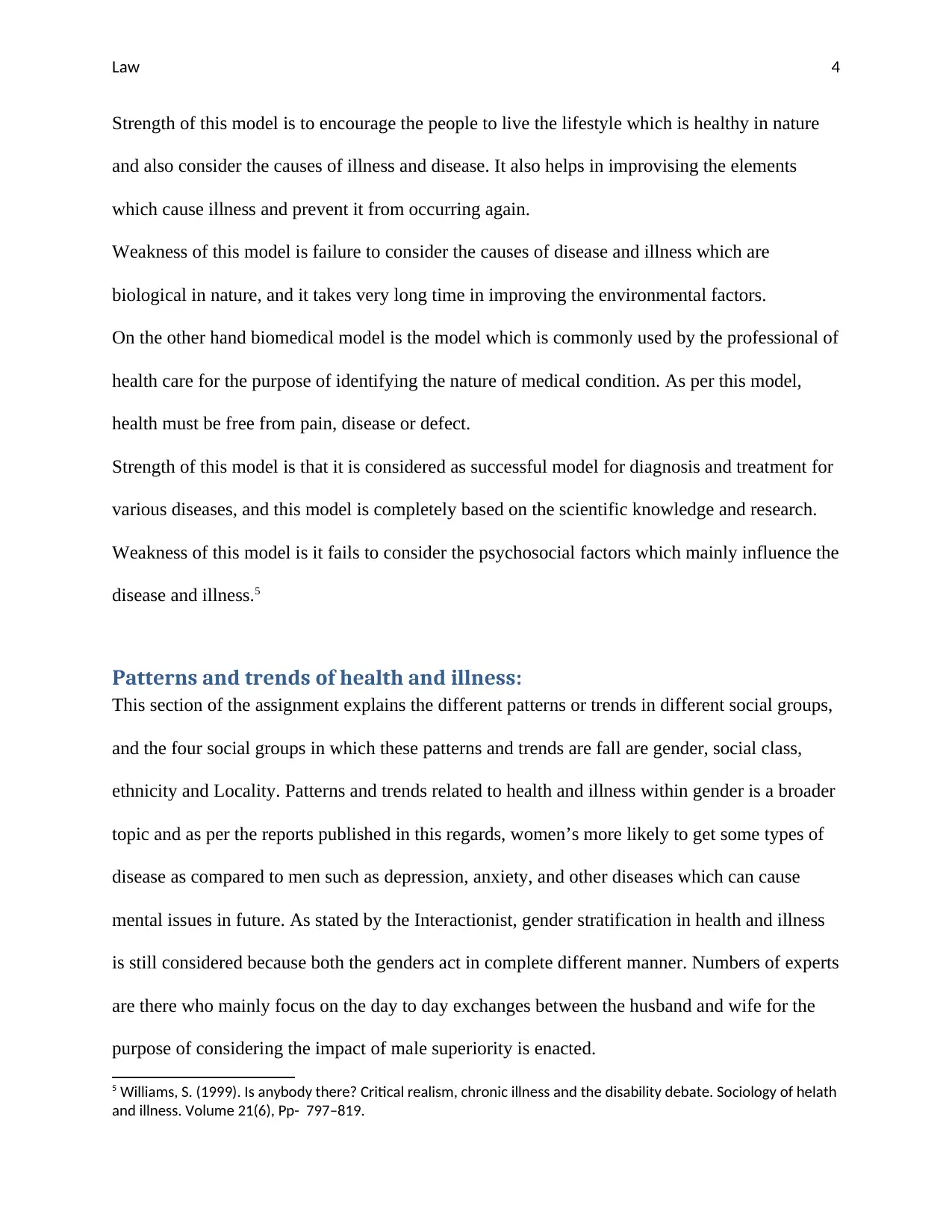
Law 4
Strength of this model is to encourage the people to live the lifestyle which is healthy in nature
and also consider the causes of illness and disease. It also helps in improvising the elements
which cause illness and prevent it from occurring again.
Weakness of this model is failure to consider the causes of disease and illness which are
biological in nature, and it takes very long time in improving the environmental factors.
On the other hand biomedical model is the model which is commonly used by the professional of
health care for the purpose of identifying the nature of medical condition. As per this model,
health must be free from pain, disease or defect.
Strength of this model is that it is considered as successful model for diagnosis and treatment for
various diseases, and this model is completely based on the scientific knowledge and research.
Weakness of this model is it fails to consider the psychosocial factors which mainly influence the
disease and illness.5
Patterns and trends of health and illness:
This section of the assignment explains the different patterns or trends in different social groups,
and the four social groups in which these patterns and trends are fall are gender, social class,
ethnicity and Locality. Patterns and trends related to health and illness within gender is a broader
topic and as per the reports published in this regards, women’s more likely to get some types of
disease as compared to men such as depression, anxiety, and other diseases which can cause
mental issues in future. As stated by the Interactionist, gender stratification in health and illness
is still considered because both the genders act in complete different manner. Numbers of experts
are there who mainly focus on the day to day exchanges between the husband and wife for the
purpose of considering the impact of male superiority is enacted.
5 Williams, S. (1999). Is anybody there? Critical realism, chronic illness and the disability debate. Sociology of helath
and illness. Volume 21(6), Pp- 797–819.
Strength of this model is to encourage the people to live the lifestyle which is healthy in nature
and also consider the causes of illness and disease. It also helps in improvising the elements
which cause illness and prevent it from occurring again.
Weakness of this model is failure to consider the causes of disease and illness which are
biological in nature, and it takes very long time in improving the environmental factors.
On the other hand biomedical model is the model which is commonly used by the professional of
health care for the purpose of identifying the nature of medical condition. As per this model,
health must be free from pain, disease or defect.
Strength of this model is that it is considered as successful model for diagnosis and treatment for
various diseases, and this model is completely based on the scientific knowledge and research.
Weakness of this model is it fails to consider the psychosocial factors which mainly influence the
disease and illness.5
Patterns and trends of health and illness:
This section of the assignment explains the different patterns or trends in different social groups,
and the four social groups in which these patterns and trends are fall are gender, social class,
ethnicity and Locality. Patterns and trends related to health and illness within gender is a broader
topic and as per the reports published in this regards, women’s more likely to get some types of
disease as compared to men such as depression, anxiety, and other diseases which can cause
mental issues in future. As stated by the Interactionist, gender stratification in health and illness
is still considered because both the genders act in complete different manner. Numbers of experts
are there who mainly focus on the day to day exchanges between the husband and wife for the
purpose of considering the impact of male superiority is enacted.
5 Williams, S. (1999). Is anybody there? Critical realism, chronic illness and the disability debate. Sociology of helath
and illness. Volume 21(6), Pp- 797–819.
Secure Best Marks with AI Grader
Need help grading? Try our AI Grader for instant feedback on your assignments.
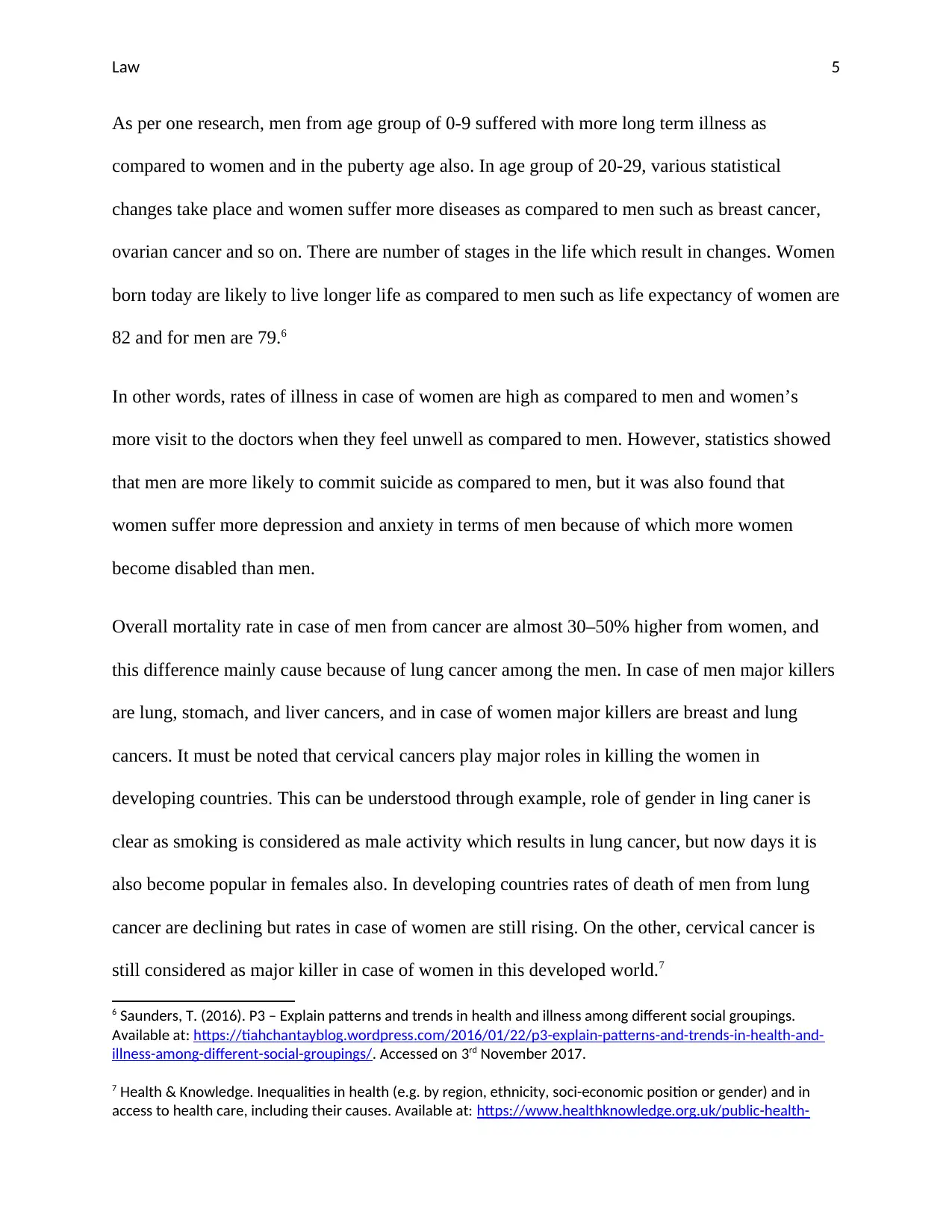
Law 5
As per one research, men from age group of 0-9 suffered with more long term illness as
compared to women and in the puberty age also. In age group of 20-29, various statistical
changes take place and women suffer more diseases as compared to men such as breast cancer,
ovarian cancer and so on. There are number of stages in the life which result in changes. Women
born today are likely to live longer life as compared to men such as life expectancy of women are
82 and for men are 79.6
In other words, rates of illness in case of women are high as compared to men and women’s
more visit to the doctors when they feel unwell as compared to men. However, statistics showed
that men are more likely to commit suicide as compared to men, but it was also found that
women suffer more depression and anxiety in terms of men because of which more women
become disabled than men.
Overall mortality rate in case of men from cancer are almost 30–50% higher from women, and
this difference mainly cause because of lung cancer among the men. In case of men major killers
are lung, stomach, and liver cancers, and in case of women major killers are breast and lung
cancers. It must be noted that cervical cancers play major roles in killing the women in
developing countries. This can be understood through example, role of gender in ling caner is
clear as smoking is considered as male activity which results in lung cancer, but now days it is
also become popular in females also. In developing countries rates of death of men from lung
cancer are declining but rates in case of women are still rising. On the other, cervical cancer is
still considered as major killer in case of women in this developed world.7
6 Saunders, T. (2016). P3 – Explain patterns and trends in health and illness among different social groupings.
Available at: https://tiahchantayblog.wordpress.com/2016/01/22/p3-explain-patterns-and-trends-in-health-and-
illness-among-different-social-groupings/. Accessed on 3rd November 2017.
7 Health & Knowledge. Inequalities in health (e.g. by region, ethnicity, soci-economic position or gender) and in
access to health care, including their causes. Available at: https://www.healthknowledge.org.uk/public-health-
As per one research, men from age group of 0-9 suffered with more long term illness as
compared to women and in the puberty age also. In age group of 20-29, various statistical
changes take place and women suffer more diseases as compared to men such as breast cancer,
ovarian cancer and so on. There are number of stages in the life which result in changes. Women
born today are likely to live longer life as compared to men such as life expectancy of women are
82 and for men are 79.6
In other words, rates of illness in case of women are high as compared to men and women’s
more visit to the doctors when they feel unwell as compared to men. However, statistics showed
that men are more likely to commit suicide as compared to men, but it was also found that
women suffer more depression and anxiety in terms of men because of which more women
become disabled than men.
Overall mortality rate in case of men from cancer are almost 30–50% higher from women, and
this difference mainly cause because of lung cancer among the men. In case of men major killers
are lung, stomach, and liver cancers, and in case of women major killers are breast and lung
cancers. It must be noted that cervical cancers play major roles in killing the women in
developing countries. This can be understood through example, role of gender in ling caner is
clear as smoking is considered as male activity which results in lung cancer, but now days it is
also become popular in females also. In developing countries rates of death of men from lung
cancer are declining but rates in case of women are still rising. On the other, cervical cancer is
still considered as major killer in case of women in this developed world.7
6 Saunders, T. (2016). P3 – Explain patterns and trends in health and illness among different social groupings.
Available at: https://tiahchantayblog.wordpress.com/2016/01/22/p3-explain-patterns-and-trends-in-health-and-
illness-among-different-social-groupings/. Accessed on 3rd November 2017.
7 Health & Knowledge. Inequalities in health (e.g. by region, ethnicity, soci-economic position or gender) and in
access to health care, including their causes. Available at: https://www.healthknowledge.org.uk/public-health-
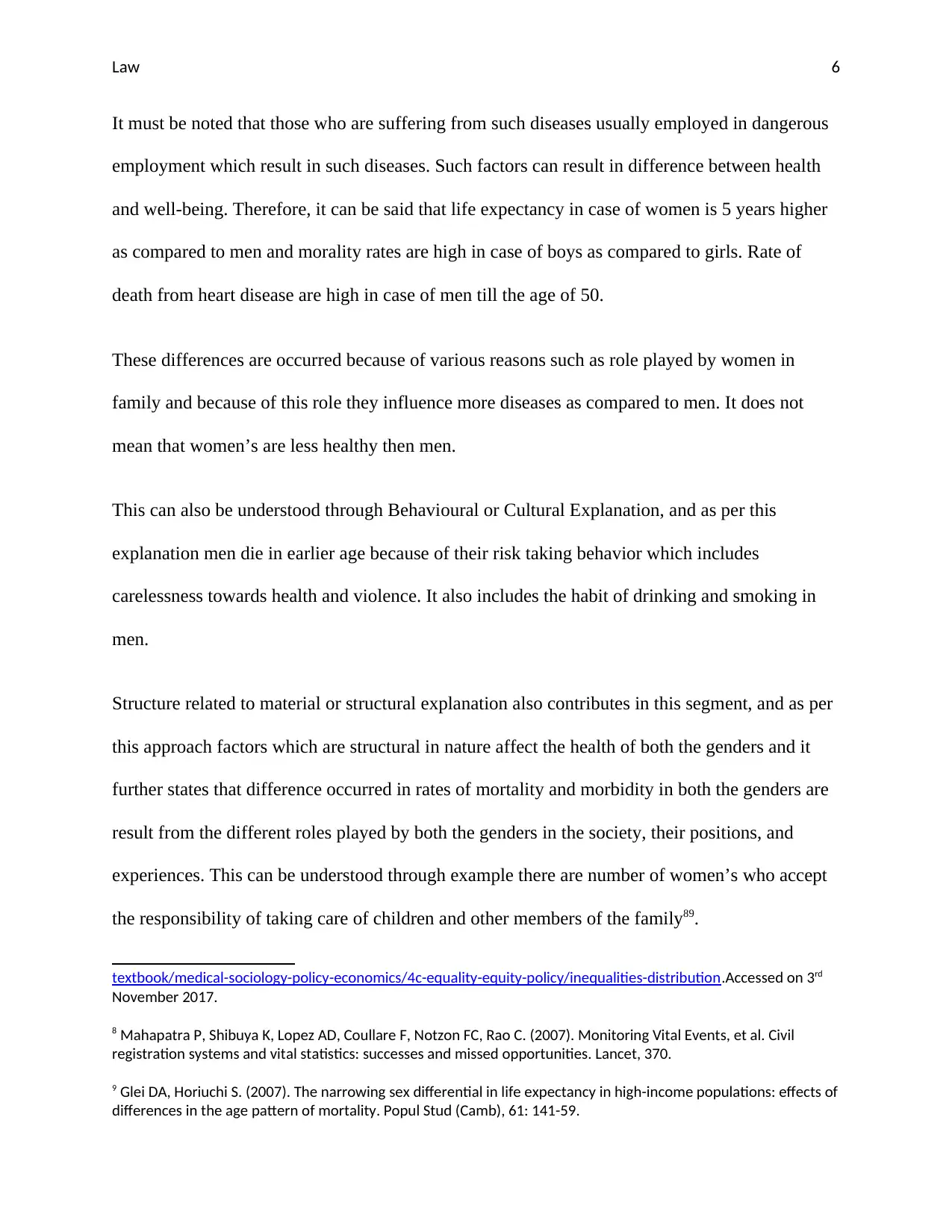
Law 6
It must be noted that those who are suffering from such diseases usually employed in dangerous
employment which result in such diseases. Such factors can result in difference between health
and well-being. Therefore, it can be said that life expectancy in case of women is 5 years higher
as compared to men and morality rates are high in case of boys as compared to girls. Rate of
death from heart disease are high in case of men till the age of 50.
These differences are occurred because of various reasons such as role played by women in
family and because of this role they influence more diseases as compared to men. It does not
mean that women’s are less healthy then men.
This can also be understood through Behavioural or Cultural Explanation, and as per this
explanation men die in earlier age because of their risk taking behavior which includes
carelessness towards health and violence. It also includes the habit of drinking and smoking in
men.
Structure related to material or structural explanation also contributes in this segment, and as per
this approach factors which are structural in nature affect the health of both the genders and it
further states that difference occurred in rates of mortality and morbidity in both the genders are
result from the different roles played by both the genders in the society, their positions, and
experiences. This can be understood through example there are number of women’s who accept
the responsibility of taking care of children and other members of the family89.
textbook/medical-sociology-policy-economics/4c-equality-equity-policy/inequalities-distribution.Accessed on 3rd
November 2017.
8 Mahapatra P, Shibuya K, Lopez AD, Coullare F, Notzon FC, Rao C. (2007). Monitoring Vital Events, et al. Civil
registration systems and vital statistics: successes and missed opportunities. Lancet, 370.
9 Glei DA, Horiuchi S. (2007). The narrowing sex differential in life expectancy in high-income populations: effects of
differences in the age pattern of mortality. Popul Stud (Camb), 61: 141-59.
It must be noted that those who are suffering from such diseases usually employed in dangerous
employment which result in such diseases. Such factors can result in difference between health
and well-being. Therefore, it can be said that life expectancy in case of women is 5 years higher
as compared to men and morality rates are high in case of boys as compared to girls. Rate of
death from heart disease are high in case of men till the age of 50.
These differences are occurred because of various reasons such as role played by women in
family and because of this role they influence more diseases as compared to men. It does not
mean that women’s are less healthy then men.
This can also be understood through Behavioural or Cultural Explanation, and as per this
explanation men die in earlier age because of their risk taking behavior which includes
carelessness towards health and violence. It also includes the habit of drinking and smoking in
men.
Structure related to material or structural explanation also contributes in this segment, and as per
this approach factors which are structural in nature affect the health of both the genders and it
further states that difference occurred in rates of mortality and morbidity in both the genders are
result from the different roles played by both the genders in the society, their positions, and
experiences. This can be understood through example there are number of women’s who accept
the responsibility of taking care of children and other members of the family89.
textbook/medical-sociology-policy-economics/4c-equality-equity-policy/inequalities-distribution.Accessed on 3rd
November 2017.
8 Mahapatra P, Shibuya K, Lopez AD, Coullare F, Notzon FC, Rao C. (2007). Monitoring Vital Events, et al. Civil
registration systems and vital statistics: successes and missed opportunities. Lancet, 370.
9 Glei DA, Horiuchi S. (2007). The narrowing sex differential in life expectancy in high-income populations: effects of
differences in the age pattern of mortality. Popul Stud (Camb), 61: 141-59.
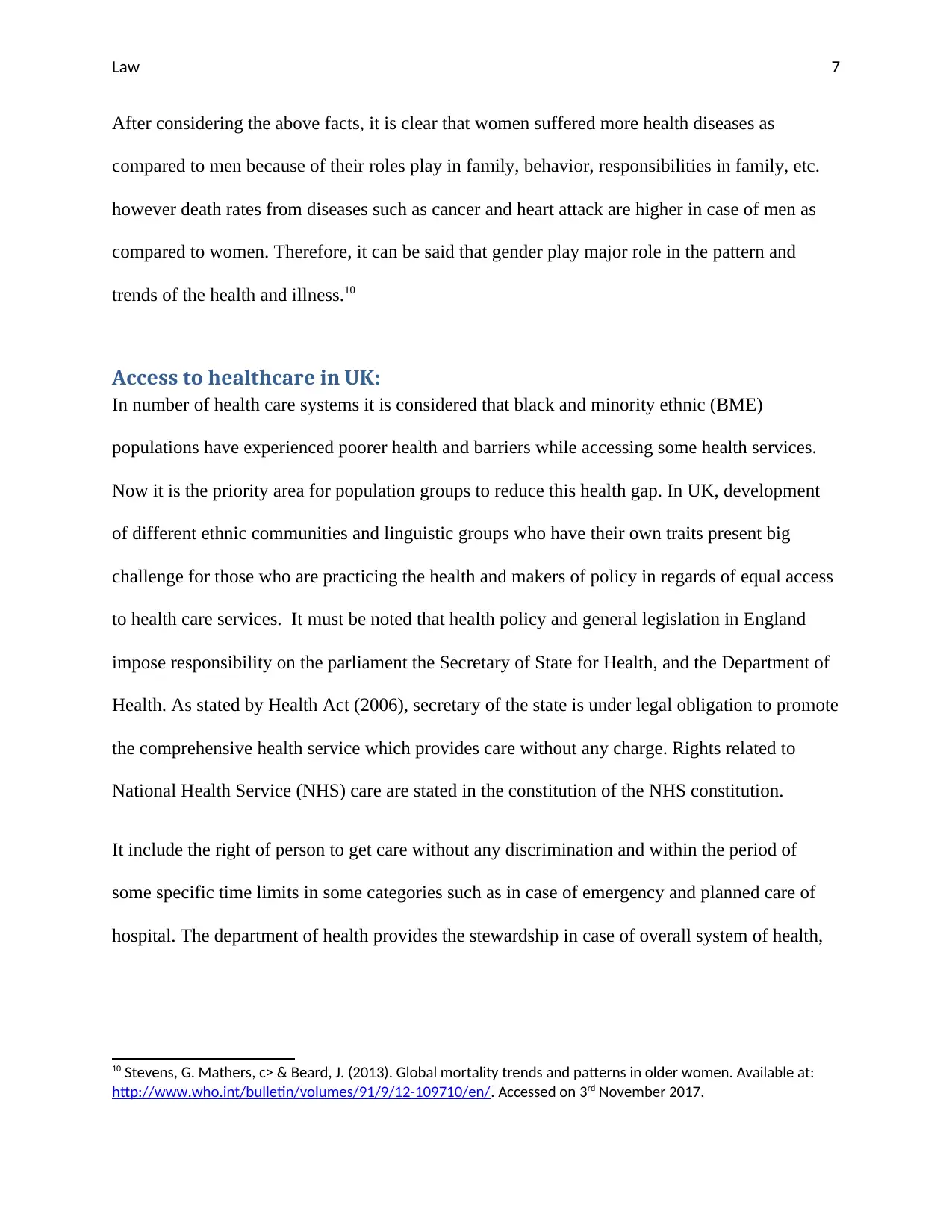
Law 7
After considering the above facts, it is clear that women suffered more health diseases as
compared to men because of their roles play in family, behavior, responsibilities in family, etc.
however death rates from diseases such as cancer and heart attack are higher in case of men as
compared to women. Therefore, it can be said that gender play major role in the pattern and
trends of the health and illness.10
Access to healthcare in UK:
In number of health care systems it is considered that black and minority ethnic (BME)
populations have experienced poorer health and barriers while accessing some health services.
Now it is the priority area for population groups to reduce this health gap. In UK, development
of different ethnic communities and linguistic groups who have their own traits present big
challenge for those who are practicing the health and makers of policy in regards of equal access
to health care services. It must be noted that health policy and general legislation in England
impose responsibility on the parliament the Secretary of State for Health, and the Department of
Health. As stated by Health Act (2006), secretary of the state is under legal obligation to promote
the comprehensive health service which provides care without any charge. Rights related to
National Health Service (NHS) care are stated in the constitution of the NHS constitution.
It include the right of person to get care without any discrimination and within the period of
some specific time limits in some categories such as in case of emergency and planned care of
hospital. The department of health provides the stewardship in case of overall system of health,
10 Stevens, G. Mathers, c> & Beard, J. (2013). Global mortality trends and patterns in older women. Available at:
http://www.who.int/bulletin/volumes/91/9/12-109710/en/. Accessed on 3rd November 2017.
After considering the above facts, it is clear that women suffered more health diseases as
compared to men because of their roles play in family, behavior, responsibilities in family, etc.
however death rates from diseases such as cancer and heart attack are higher in case of men as
compared to women. Therefore, it can be said that gender play major role in the pattern and
trends of the health and illness.10
Access to healthcare in UK:
In number of health care systems it is considered that black and minority ethnic (BME)
populations have experienced poorer health and barriers while accessing some health services.
Now it is the priority area for population groups to reduce this health gap. In UK, development
of different ethnic communities and linguistic groups who have their own traits present big
challenge for those who are practicing the health and makers of policy in regards of equal access
to health care services. It must be noted that health policy and general legislation in England
impose responsibility on the parliament the Secretary of State for Health, and the Department of
Health. As stated by Health Act (2006), secretary of the state is under legal obligation to promote
the comprehensive health service which provides care without any charge. Rights related to
National Health Service (NHS) care are stated in the constitution of the NHS constitution.
It include the right of person to get care without any discrimination and within the period of
some specific time limits in some categories such as in case of emergency and planned care of
hospital. The department of health provides the stewardship in case of overall system of health,
10 Stevens, G. Mathers, c> & Beard, J. (2013). Global mortality trends and patterns in older women. Available at:
http://www.who.int/bulletin/volumes/91/9/12-109710/en/. Accessed on 3rd November 2017.
Paraphrase This Document
Need a fresh take? Get an instant paraphrase of this document with our AI Paraphraser
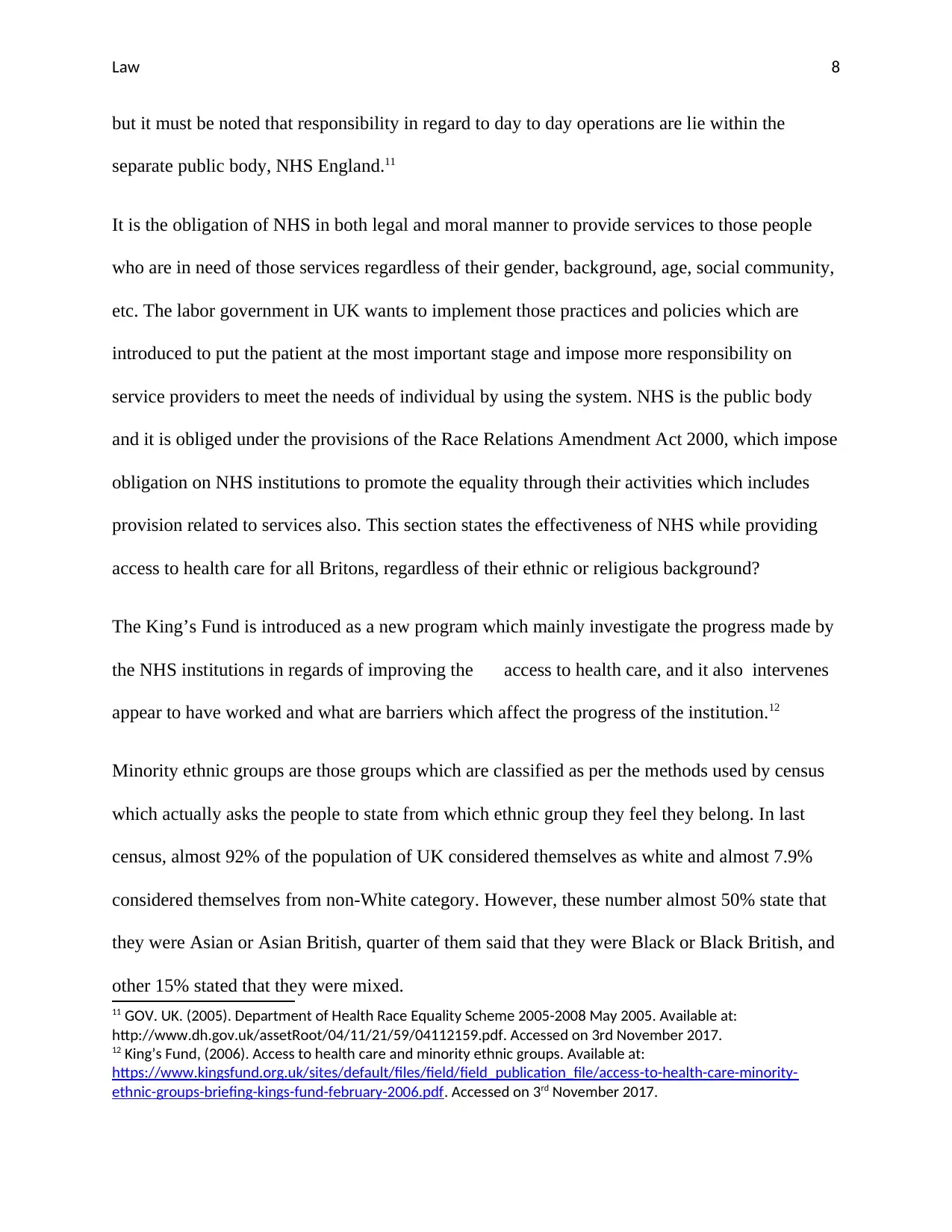
Law 8
but it must be noted that responsibility in regard to day to day operations are lie within the
separate public body, NHS England.11
It is the obligation of NHS in both legal and moral manner to provide services to those people
who are in need of those services regardless of their gender, background, age, social community,
etc. The labor government in UK wants to implement those practices and policies which are
introduced to put the patient at the most important stage and impose more responsibility on
service providers to meet the needs of individual by using the system. NHS is the public body
and it is obliged under the provisions of the Race Relations Amendment Act 2000, which impose
obligation on NHS institutions to promote the equality through their activities which includes
provision related to services also. This section states the effectiveness of NHS while providing
access to health care for all Britons, regardless of their ethnic or religious background?
The King’s Fund is introduced as a new program which mainly investigate the progress made by
the NHS institutions in regards of improving the access to health care, and it also intervenes
appear to have worked and what are barriers which affect the progress of the institution.12
Minority ethnic groups are those groups which are classified as per the methods used by census
which actually asks the people to state from which ethnic group they feel they belong. In last
census, almost 92% of the population of UK considered themselves as white and almost 7.9%
considered themselves from non-White category. However, these number almost 50% state that
they were Asian or Asian British, quarter of them said that they were Black or Black British, and
other 15% stated that they were mixed.
11 GOV. UK. (2005). Department of Health Race Equality Scheme 2005-2008 May 2005. Available at:
http://www.dh.gov.uk/assetRoot/04/11/21/59/04112159.pdf. Accessed on 3rd November 2017.
12 King’s Fund, (2006). Access to health care and minority ethnic groups. Available at:
https://www.kingsfund.org.uk/sites/default/files/field/field_publication_file/access-to-health-care-minority-
ethnic-groups-briefing-kings-fund-february-2006.pdf. Accessed on 3rd November 2017.
but it must be noted that responsibility in regard to day to day operations are lie within the
separate public body, NHS England.11
It is the obligation of NHS in both legal and moral manner to provide services to those people
who are in need of those services regardless of their gender, background, age, social community,
etc. The labor government in UK wants to implement those practices and policies which are
introduced to put the patient at the most important stage and impose more responsibility on
service providers to meet the needs of individual by using the system. NHS is the public body
and it is obliged under the provisions of the Race Relations Amendment Act 2000, which impose
obligation on NHS institutions to promote the equality through their activities which includes
provision related to services also. This section states the effectiveness of NHS while providing
access to health care for all Britons, regardless of their ethnic or religious background?
The King’s Fund is introduced as a new program which mainly investigate the progress made by
the NHS institutions in regards of improving the access to health care, and it also intervenes
appear to have worked and what are barriers which affect the progress of the institution.12
Minority ethnic groups are those groups which are classified as per the methods used by census
which actually asks the people to state from which ethnic group they feel they belong. In last
census, almost 92% of the population of UK considered themselves as white and almost 7.9%
considered themselves from non-White category. However, these number almost 50% state that
they were Asian or Asian British, quarter of them said that they were Black or Black British, and
other 15% stated that they were mixed.
11 GOV. UK. (2005). Department of Health Race Equality Scheme 2005-2008 May 2005. Available at:
http://www.dh.gov.uk/assetRoot/04/11/21/59/04112159.pdf. Accessed on 3rd November 2017.
12 King’s Fund, (2006). Access to health care and minority ethnic groups. Available at:
https://www.kingsfund.org.uk/sites/default/files/field/field_publication_file/access-to-health-care-minority-
ethnic-groups-briefing-kings-fund-february-2006.pdf. Accessed on 3rd November 2017.
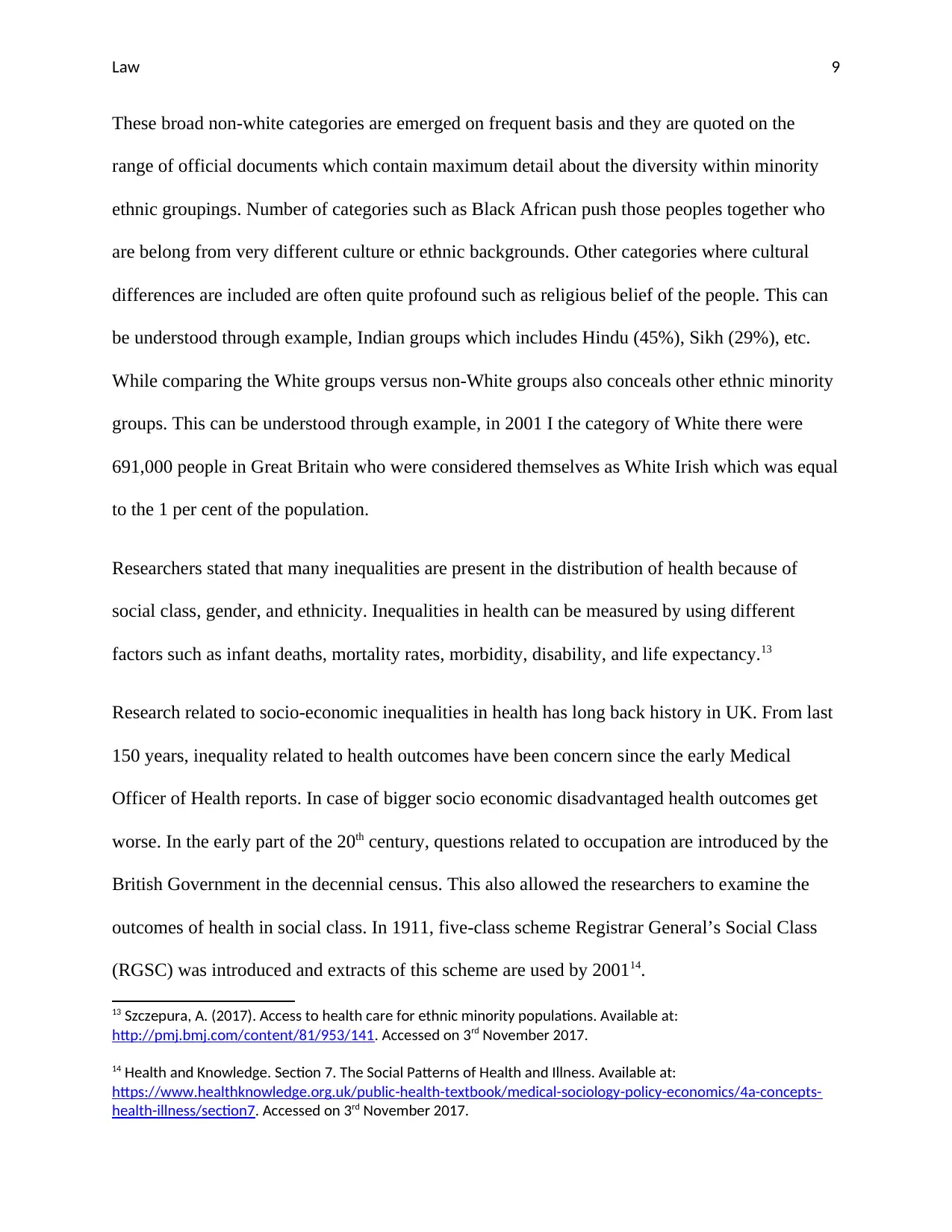
Law 9
These broad non-white categories are emerged on frequent basis and they are quoted on the
range of official documents which contain maximum detail about the diversity within minority
ethnic groupings. Number of categories such as Black African push those peoples together who
are belong from very different culture or ethnic backgrounds. Other categories where cultural
differences are included are often quite profound such as religious belief of the people. This can
be understood through example, Indian groups which includes Hindu (45%), Sikh (29%), etc.
While comparing the White groups versus non-White groups also conceals other ethnic minority
groups. This can be understood through example, in 2001 I the category of White there were
691,000 people in Great Britain who were considered themselves as White Irish which was equal
to the 1 per cent of the population.
Researchers stated that many inequalities are present in the distribution of health because of
social class, gender, and ethnicity. Inequalities in health can be measured by using different
factors such as infant deaths, mortality rates, morbidity, disability, and life expectancy.13
Research related to socio-economic inequalities in health has long back history in UK. From last
150 years, inequality related to health outcomes have been concern since the early Medical
Officer of Health reports. In case of bigger socio economic disadvantaged health outcomes get
worse. In the early part of the 20th century, questions related to occupation are introduced by the
British Government in the decennial census. This also allowed the researchers to examine the
outcomes of health in social class. In 1911, five-class scheme Registrar General’s Social Class
(RGSC) was introduced and extracts of this scheme are used by 200114.
13 Szczepura, A. (2017). Access to health care for ethnic minority populations. Available at:
http://pmj.bmj.com/content/81/953/141. Accessed on 3rd November 2017.
14 Health and Knowledge. Section 7. The Social Patterns of Health and Illness. Available at:
https://www.healthknowledge.org.uk/public-health-textbook/medical-sociology-policy-economics/4a-concepts-
health-illness/section7. Accessed on 3rd November 2017.
These broad non-white categories are emerged on frequent basis and they are quoted on the
range of official documents which contain maximum detail about the diversity within minority
ethnic groupings. Number of categories such as Black African push those peoples together who
are belong from very different culture or ethnic backgrounds. Other categories where cultural
differences are included are often quite profound such as religious belief of the people. This can
be understood through example, Indian groups which includes Hindu (45%), Sikh (29%), etc.
While comparing the White groups versus non-White groups also conceals other ethnic minority
groups. This can be understood through example, in 2001 I the category of White there were
691,000 people in Great Britain who were considered themselves as White Irish which was equal
to the 1 per cent of the population.
Researchers stated that many inequalities are present in the distribution of health because of
social class, gender, and ethnicity. Inequalities in health can be measured by using different
factors such as infant deaths, mortality rates, morbidity, disability, and life expectancy.13
Research related to socio-economic inequalities in health has long back history in UK. From last
150 years, inequality related to health outcomes have been concern since the early Medical
Officer of Health reports. In case of bigger socio economic disadvantaged health outcomes get
worse. In the early part of the 20th century, questions related to occupation are introduced by the
British Government in the decennial census. This also allowed the researchers to examine the
outcomes of health in social class. In 1911, five-class scheme Registrar General’s Social Class
(RGSC) was introduced and extracts of this scheme are used by 200114.
13 Szczepura, A. (2017). Access to health care for ethnic minority populations. Available at:
http://pmj.bmj.com/content/81/953/141. Accessed on 3rd November 2017.
14 Health and Knowledge. Section 7. The Social Patterns of Health and Illness. Available at:
https://www.healthknowledge.org.uk/public-health-textbook/medical-sociology-policy-economics/4a-concepts-
health-illness/section7. Accessed on 3rd November 2017.
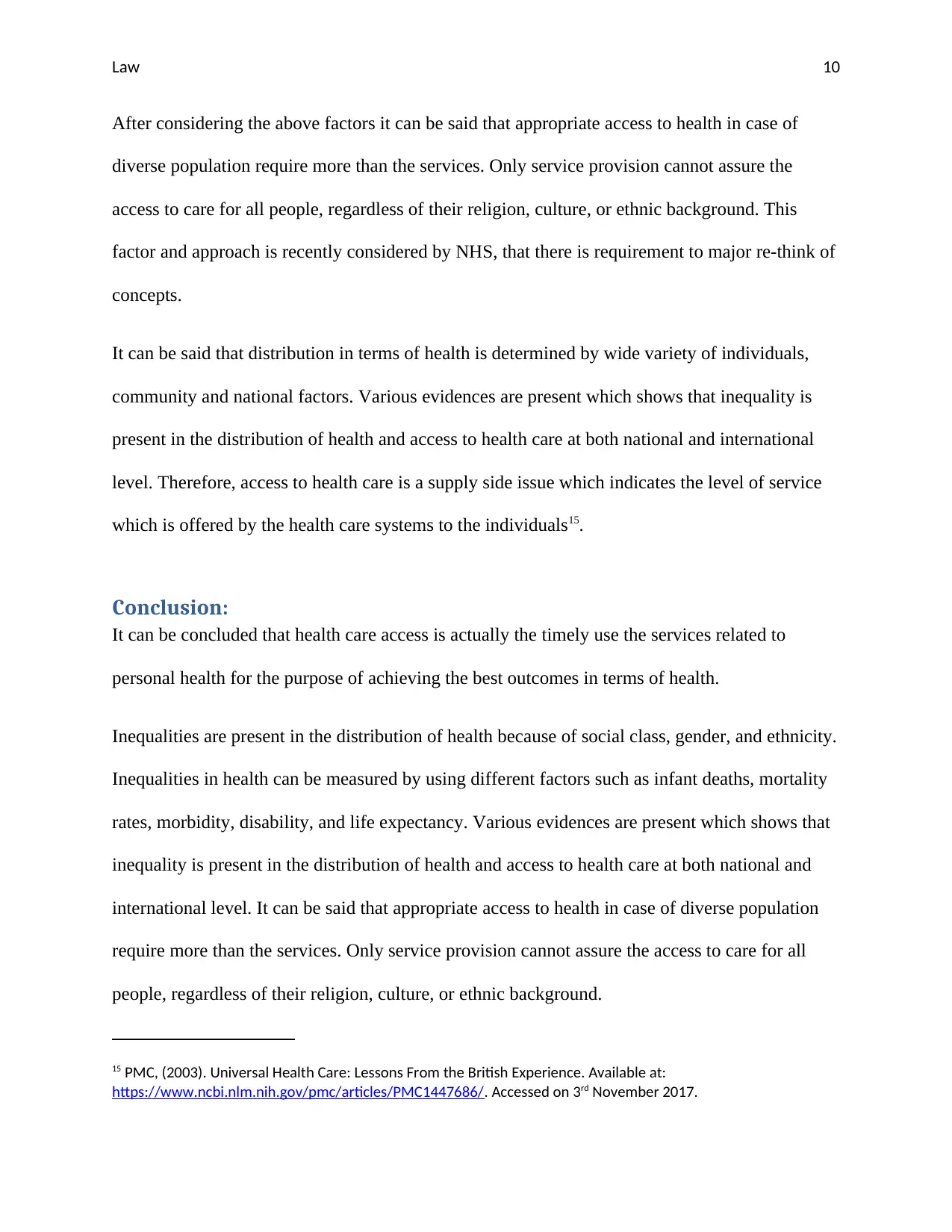
Law 10
After considering the above factors it can be said that appropriate access to health in case of
diverse population require more than the services. Only service provision cannot assure the
access to care for all people, regardless of their religion, culture, or ethnic background. This
factor and approach is recently considered by NHS, that there is requirement to major re-think of
concepts.
It can be said that distribution in terms of health is determined by wide variety of individuals,
community and national factors. Various evidences are present which shows that inequality is
present in the distribution of health and access to health care at both national and international
level. Therefore, access to health care is a supply side issue which indicates the level of service
which is offered by the health care systems to the individuals15.
Conclusion:
It can be concluded that health care access is actually the timely use the services related to
personal health for the purpose of achieving the best outcomes in terms of health.
Inequalities are present in the distribution of health because of social class, gender, and ethnicity.
Inequalities in health can be measured by using different factors such as infant deaths, mortality
rates, morbidity, disability, and life expectancy. Various evidences are present which shows that
inequality is present in the distribution of health and access to health care at both national and
international level. It can be said that appropriate access to health in case of diverse population
require more than the services. Only service provision cannot assure the access to care for all
people, regardless of their religion, culture, or ethnic background.
15 PMC, (2003). Universal Health Care: Lessons From the British Experience. Available at:
https://www.ncbi.nlm.nih.gov/pmc/articles/PMC1447686/. Accessed on 3rd November 2017.
After considering the above factors it can be said that appropriate access to health in case of
diverse population require more than the services. Only service provision cannot assure the
access to care for all people, regardless of their religion, culture, or ethnic background. This
factor and approach is recently considered by NHS, that there is requirement to major re-think of
concepts.
It can be said that distribution in terms of health is determined by wide variety of individuals,
community and national factors. Various evidences are present which shows that inequality is
present in the distribution of health and access to health care at both national and international
level. Therefore, access to health care is a supply side issue which indicates the level of service
which is offered by the health care systems to the individuals15.
Conclusion:
It can be concluded that health care access is actually the timely use the services related to
personal health for the purpose of achieving the best outcomes in terms of health.
Inequalities are present in the distribution of health because of social class, gender, and ethnicity.
Inequalities in health can be measured by using different factors such as infant deaths, mortality
rates, morbidity, disability, and life expectancy. Various evidences are present which shows that
inequality is present in the distribution of health and access to health care at both national and
international level. It can be said that appropriate access to health in case of diverse population
require more than the services. Only service provision cannot assure the access to care for all
people, regardless of their religion, culture, or ethnic background.
15 PMC, (2003). Universal Health Care: Lessons From the British Experience. Available at:
https://www.ncbi.nlm.nih.gov/pmc/articles/PMC1447686/. Accessed on 3rd November 2017.
Secure Best Marks with AI Grader
Need help grading? Try our AI Grader for instant feedback on your assignments.

Law 11
BIBLIOGRAPHY
Website
BIBLIOGRAPHY
Website
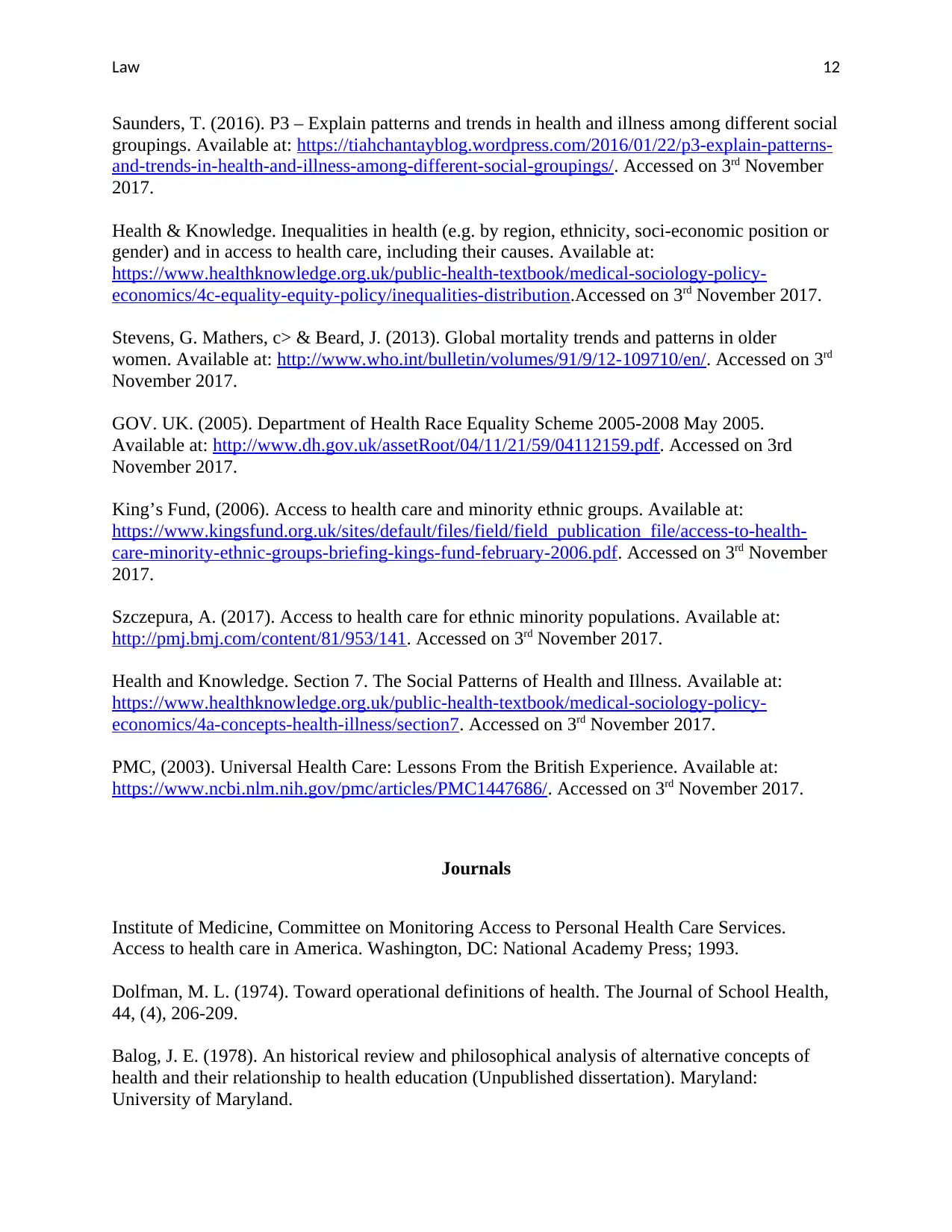
Law 12
Saunders, T. (2016). P3 – Explain patterns and trends in health and illness among different social
groupings. Available at: https://tiahchantayblog.wordpress.com/2016/01/22/p3-explain-patterns-
and-trends-in-health-and-illness-among-different-social-groupings/. Accessed on 3rd November
2017.
Health & Knowledge. Inequalities in health (e.g. by region, ethnicity, soci-economic position or
gender) and in access to health care, including their causes. Available at:
https://www.healthknowledge.org.uk/public-health-textbook/medical-sociology-policy-
economics/4c-equality-equity-policy/inequalities-distribution.Accessed on 3rd November 2017.
Stevens, G. Mathers, c> & Beard, J. (2013). Global mortality trends and patterns in older
women. Available at: http://www.who.int/bulletin/volumes/91/9/12-109710/en/. Accessed on 3rd
November 2017.
GOV. UK. (2005). Department of Health Race Equality Scheme 2005-2008 May 2005.
Available at: http://www.dh.gov.uk/assetRoot/04/11/21/59/04112159.pdf. Accessed on 3rd
November 2017.
King’s Fund, (2006). Access to health care and minority ethnic groups. Available at:
https://www.kingsfund.org.uk/sites/default/files/field/field_publication_file/access-to-health-
care-minority-ethnic-groups-briefing-kings-fund-february-2006.pdf. Accessed on 3rd November
2017.
Szczepura, A. (2017). Access to health care for ethnic minority populations. Available at:
http://pmj.bmj.com/content/81/953/141. Accessed on 3rd November 2017.
Health and Knowledge. Section 7. The Social Patterns of Health and Illness. Available at:
https://www.healthknowledge.org.uk/public-health-textbook/medical-sociology-policy-
economics/4a-concepts-health-illness/section7. Accessed on 3rd November 2017.
PMC, (2003). Universal Health Care: Lessons From the British Experience. Available at:
https://www.ncbi.nlm.nih.gov/pmc/articles/PMC1447686/. Accessed on 3rd November 2017.
Journals
Institute of Medicine, Committee on Monitoring Access to Personal Health Care Services.
Access to health care in America. Washington, DC: National Academy Press; 1993.
Dolfman, M. L. (1974). Toward operational definitions of health. The Journal of School Health,
44, (4), 206-209.
Balog, J. E. (1978). An historical review and philosophical analysis of alternative concepts of
health and their relationship to health education (Unpublished dissertation). Maryland:
University of Maryland.
Saunders, T. (2016). P3 – Explain patterns and trends in health and illness among different social
groupings. Available at: https://tiahchantayblog.wordpress.com/2016/01/22/p3-explain-patterns-
and-trends-in-health-and-illness-among-different-social-groupings/. Accessed on 3rd November
2017.
Health & Knowledge. Inequalities in health (e.g. by region, ethnicity, soci-economic position or
gender) and in access to health care, including their causes. Available at:
https://www.healthknowledge.org.uk/public-health-textbook/medical-sociology-policy-
economics/4c-equality-equity-policy/inequalities-distribution.Accessed on 3rd November 2017.
Stevens, G. Mathers, c> & Beard, J. (2013). Global mortality trends and patterns in older
women. Available at: http://www.who.int/bulletin/volumes/91/9/12-109710/en/. Accessed on 3rd
November 2017.
GOV. UK. (2005). Department of Health Race Equality Scheme 2005-2008 May 2005.
Available at: http://www.dh.gov.uk/assetRoot/04/11/21/59/04112159.pdf. Accessed on 3rd
November 2017.
King’s Fund, (2006). Access to health care and minority ethnic groups. Available at:
https://www.kingsfund.org.uk/sites/default/files/field/field_publication_file/access-to-health-
care-minority-ethnic-groups-briefing-kings-fund-february-2006.pdf. Accessed on 3rd November
2017.
Szczepura, A. (2017). Access to health care for ethnic minority populations. Available at:
http://pmj.bmj.com/content/81/953/141. Accessed on 3rd November 2017.
Health and Knowledge. Section 7. The Social Patterns of Health and Illness. Available at:
https://www.healthknowledge.org.uk/public-health-textbook/medical-sociology-policy-
economics/4a-concepts-health-illness/section7. Accessed on 3rd November 2017.
PMC, (2003). Universal Health Care: Lessons From the British Experience. Available at:
https://www.ncbi.nlm.nih.gov/pmc/articles/PMC1447686/. Accessed on 3rd November 2017.
Journals
Institute of Medicine, Committee on Monitoring Access to Personal Health Care Services.
Access to health care in America. Washington, DC: National Academy Press; 1993.
Dolfman, M. L. (1974). Toward operational definitions of health. The Journal of School Health,
44, (4), 206-209.
Balog, J. E. (1978). An historical review and philosophical analysis of alternative concepts of
health and their relationship to health education (Unpublished dissertation). Maryland:
University of Maryland.
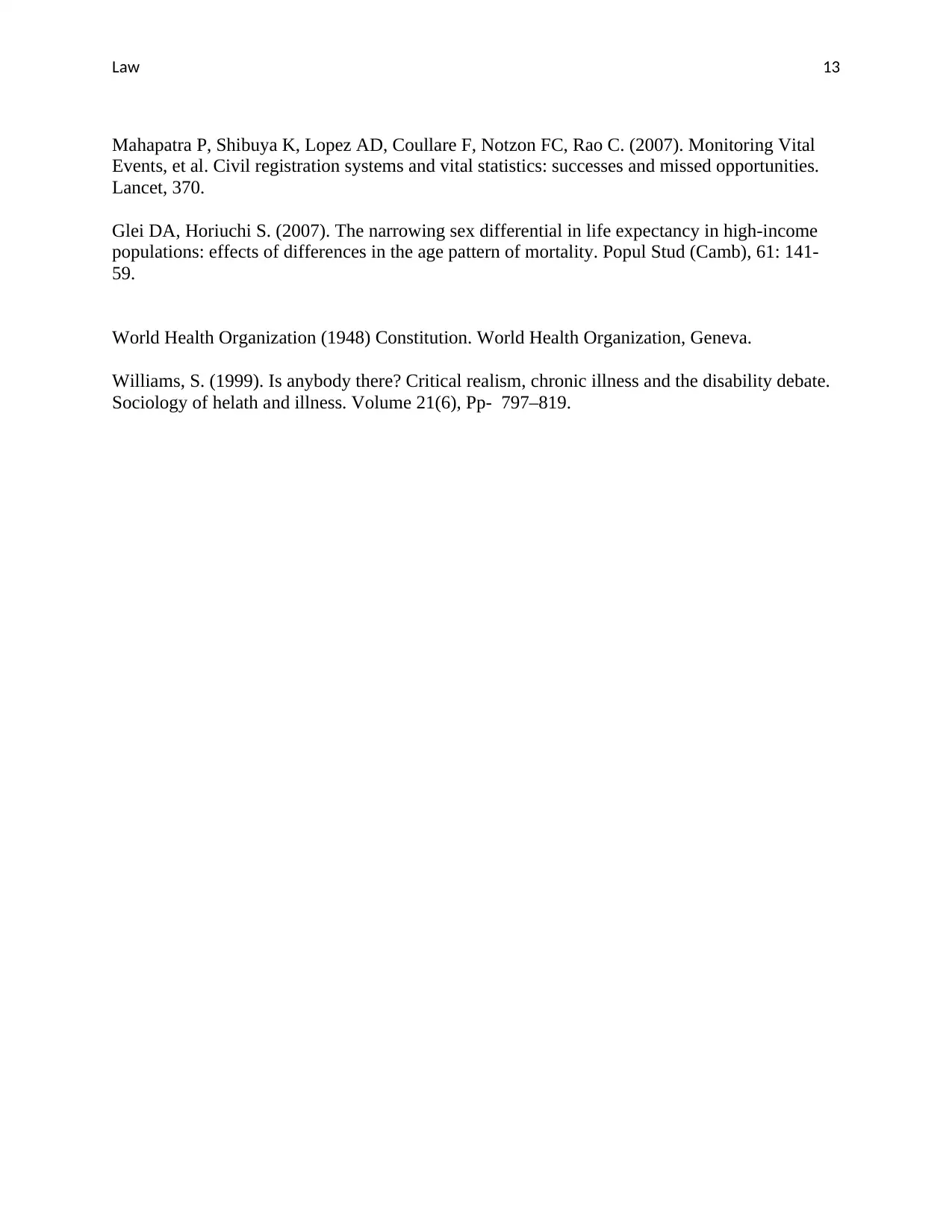
Law 13
Mahapatra P, Shibuya K, Lopez AD, Coullare F, Notzon FC, Rao C. (2007). Monitoring Vital
Events, et al. Civil registration systems and vital statistics: successes and missed opportunities.
Lancet, 370.
Glei DA, Horiuchi S. (2007). The narrowing sex differential in life expectancy in high-income
populations: effects of differences in the age pattern of mortality. Popul Stud (Camb), 61: 141-
59.
World Health Organization (1948) Constitution. World Health Organization, Geneva.
Williams, S. (1999). Is anybody there? Critical realism, chronic illness and the disability debate.
Sociology of helath and illness. Volume 21(6), Pp- 797–819.
Mahapatra P, Shibuya K, Lopez AD, Coullare F, Notzon FC, Rao C. (2007). Monitoring Vital
Events, et al. Civil registration systems and vital statistics: successes and missed opportunities.
Lancet, 370.
Glei DA, Horiuchi S. (2007). The narrowing sex differential in life expectancy in high-income
populations: effects of differences in the age pattern of mortality. Popul Stud (Camb), 61: 141-
59.
World Health Organization (1948) Constitution. World Health Organization, Geneva.
Williams, S. (1999). Is anybody there? Critical realism, chronic illness and the disability debate.
Sociology of helath and illness. Volume 21(6), Pp- 797–819.
1 out of 13
Related Documents
Your All-in-One AI-Powered Toolkit for Academic Success.
+13062052269
info@desklib.com
Available 24*7 on WhatsApp / Email
![[object Object]](/_next/static/media/star-bottom.7253800d.svg)
Unlock your academic potential
© 2024 | Zucol Services PVT LTD | All rights reserved.




